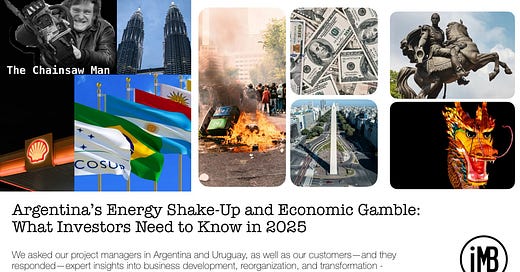📩 Argentina Executive Brief — June 2025 Edition
Argentina is at a crossroads—economically, politically, and geopolitically. The headlines may tell a story of stabilization and reform, but the deeper currents reveal a different scenario.
Preface
Petronas is leaving Argentina’s shale. Shell and Cosan are leaving 🇦🇷. Inflation is down, but so is competitiveness. Milei is rewriting the rules of trade and governance. International capital isn't really coming into the Pampa Nation.
However, if you look at platforms such as X, formerly Twitter, or LinkedIn, a completely different story is told. We had our project managers from the Commodities Tokenizing Project talk to entrepreneurs, financial market professionals, and consultants in Argentina.
And they wrote short blogs that pack a punch. So you want to know what's really happening in Argentina right now and not just accept the social media noise on X and LinkedIn as “the truth” in passing?
🛢️ Petronas Eyes Exit: Global Energy Majors Retreat from Argentina’s Shale Dream
The tectonic plates beneath Argentina’s energy landscape are shifting once again. Petronas is reportedly evaluating the sale of its 50% stake in the La Amarga Chica joint venture with YPF, potentially marking its exit from the prolific—but troubled—Vaca Muerta shale basin.
Often dubbed the “Permian of the South,” Vaca Muerta has been a magnet for international oil majors. But now, companies like ExxonMobil (which recently sold to Pluspetrol), Equinor (currently in talks to divest), and even TotalEnergies are hitting the brakes. What’s going on?
Despite its world-class reserves, Argentina’s economic instability, unpredictable regulations, and global decarbonization strategies are weighing heavily on boardroom decisions. The result: a quiet exodus, with local and regional players poised to step into the vacuum.
This shift is more than a change in corporate portfolios—it’s a realignment on the geopolitical energy chessboard. For investors, analysts, and strategists, understanding who exits (and who stays) in Argentina’s shale sector is mission-critical.
💸 Inflation Down, Deficit Up: Argentina’s Currency Conundrum
President Javier Milei’s economic overhaul has delivered a headline-grabbing win: inflation has dropped below 90% year-over-year. But look under the hood, and a new imbalance is emerging.
In early 2025, Argentina’s current account deficit ballooned to $1.656 billion. The culprit? A dangerously overvalued peso and a crawling peg policy that’s hurting exports, eroding trade surpluses, and hiking up import costs. The risk of a sudden correction is rising—and with elections on the horizon, bold policy shifts are politically toxic.
Don’t be fooled by the stabilization narrative. For international investors, Milei’s short-term inflation fix may be masking deeper structural vulnerabilities. The ghosts of the Macri era are back—and the IMF is once again in the passenger seat.
📊 ERBS 2024: Stabilization or Smoke and Mirrors?
Argentina’s latest economic stabilization program, ERBS 2024, is fast and furious. Credit is flowing, the fiscal belt is tightening, and currency controls remain firmly in place. But is this new approach sustainable?
With reserves still under pressure, capital controls distorting markets, and long-term investment still lagging, Argentina’s "stability" may prove fragile. This edition unpacks the hidden fragilities of the current program—and what investors must watch if they hope to ride out the volatility.
🧾 BOPREAL IV: A Lifeline for Importers and Multinationals
The Central Bank’s fourth series of BOPREAL bonds is a tactical response to Argentina’s foreign exchange backlog. With principal in U.S. dollars due in 2028 and up to $3 billion available, this new issuance offers much-needed breathing room for companies dealing with blocked dividends and import debts.
It’s more than a bond—it’s a pressure valve for Argentina’s distorted FX market and a strategic opportunity for savvy operators to de-risk their local operations.
🌎 Exit Mercosur? Milei’s Risky Trade Gamble
President Milei is shaking the pillars of South American integration. His open criticism of Mercosur and flirtation with a U.S.-Argentina trade deal could upend Argentina’s industrial backbone—particularly in the automotive and agri-export sectors.
This edition dives into the complex trade-offs of a Mercosur exit, the improbability of a meaningful U.S. trade deal, and the cascading impact on inflation, supply chains, and political stability across the Southern Cone.
💰 Beijing to the Rescue? China Extends Lifeline
In a move that underscores Argentina’s financial tightrope, China has extended its $5 billion currency swap, part of a broader $18 billion arrangement. Combined with a fresh $20 billion IMF loan, Milei’s government has gained critical short-term breathing room.
But this dual alignment—with Washington and Beijing—places Argentina in a precarious geopolitical balancing act. How long can it last?
🔥 The Real Cost of Milei’s Austerity: Surplus or Sacrifice?
Milei’s radical libertarian policies have earned him praise in financial markets. But at what cost?
Over half of Argentinians now live below the poverty line. Public services are being gutted, entire ministries dissolved, and constitutional norms eroded. This isn’t just a fiscal surplus—it’s a social implosion. Investors and policymakers must factor in growing domestic instability as part of Argentina’s evolving risk profile.
🇨🇳 China in Venezuela: A Warning for Argentina?
With Chinese influence rising across Latin America, Milei’s government must tread carefully. Venezuela's experience with Chinese financing—trading sovereignty for liquidity—offers a cautionary tale. Argentina’s growing reliance on Chinese swaps, BRI investments, and critical mineral partnerships raises strategic questions about the country’s long-term autonomy.
Final Takeaway
Argentina is at a crossroads—economically, politically, and geopolitically. The headlines may tell a story of stabilization and reform, but the deeper currents reveal fragility, realignment, and mounting risk. For global investors, energy strategists, and Latin America analysts, this is a time for rigorous due diligence and forward-looking scenario planning.
🔍 Read the full story and get ahead of Latin America's most volatile energy and economic pivot 🇦🇷:
👉 Read 🇦🇷 Executive Brief June 2025
📬 Want more insight like this? Subscribe to GreyRhino Newsletter – your lens into Latin America’s shifting business, energy, and political dynamics.










